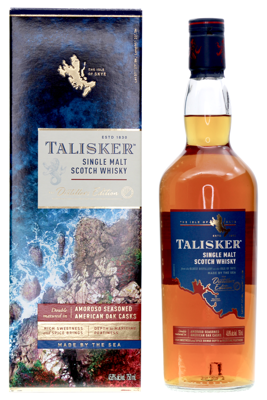|
|
Release Notes
The DISTILLERS EDITION is a collection of master-craftsmanship. Each cask in the series is individually selected and perfectly matched to the character of each of the single malts refined here. The two-parted maturation process gives more depth and complexity, which is the idea behind the limited DISTILLERS EDITION: preserving the perfection of the single malts that have already been awarded for their outstanding flavours. The selected taste nuances are more strongly accentuated in a way that is not found in the regular bottlings, but with fully maintaining the original character of these fine single malts.
Talisker
3rd Party Tasting Notes
Body: Full.
Finish: Long, powerful and while still sweet, now drying too, with lingering peat smoke and cocoa nibs.
Nose: A pungent nose with clean ozone-fresh sea-air and beach seaweed backed by richer, smokier notes, sweet malt and sultana sweetness from the cask; gloriously well combined and harmonious.
Palate: An oily-smooth texture, the taste at once smoky and briny yet sweet with rich fruit too, quickly growing more peppery, as woody spiciness takes a clear interest. Luxurious suggestions of roasted fig and sweet date are firmly backed throughout by peat smoke and sea-salt, and there’s a smoothness to the chili ‘catch’ as it goes down.
Finish: Long, powerful and while still sweet, now drying too, with lingering peat smoke and cocoa nibs.
Nose: A pungent nose with clean ozone-fresh sea-air and beach seaweed backed by richer, smokier notes, sweet malt and sultana sweetness from the cask; gloriously well combined and harmonious.
Palate: An oily-smooth texture, the taste at once smoky and briny yet sweet with rich fruit too, quickly growing more peppery, as woody spiciness takes a clear interest. Luxurious suggestions of roasted fig and sweet date are firmly backed throughout by peat smoke and sea-salt, and there’s a smoothness to the chili ‘catch’ as it goes down.
Talisker
The Distillery: Talisker
| Established: 1830 |
| Silent since: False |
| Address: Carbost, Isle Of Skye IV47 8SR, UK |
| → website |
During the 1990"s Talisker was usually one of the first single malts that a relative malt whisky novice would get to try. As part of Diageo"s series of six "Classic Malts" (along with Cragganmore, Dalwhinnie, Glenkinchie, Oban and Lagavulin on Islay) it was one of the few Scotch single malts that could be found on the shelves of almost every reasonably stocked liquorist.
Roderick Kemp sold his share of Talisker in 1892 and used the proceeds to buy Macallan. Ownership of Talisker kept changing in the decades after that, until DCL took control in 1916. The method of triple distillation that was traditionally employed at Talisker was abandoned in 1928. After administration of the distillery was transferred to Scottish Malt Distillers (SMD, predecessors of Diageo) in 1930, things quieted down for a while at Talisker for a few decades. However, in 1960 there was a large fire at the distillery. Talisker was closed for two years, during which time they commissioned the construction of identical copies of the five stills that were damaged or destroyed in the fire.
Talisker re-opened its doors in 1962 and proceeded as before until 1972. At that point the malting at the distillery stopped. From then on the barley was malted at the Glen Ord Central Maltings in the Highlands.
Talisker was built in 1830 by brothers Kenneth and Hugh MacAskill. As sons of the local doctor they were part of the establishment, so it"s unlikely they would have embraced the fine art of distillation so bravely if it had still been an illegal practice. But for those that took the trouble of obrtaining a license it wasn"t anymore, so distillation at Talikser was started in 1831. Everything proceeded smoothly for two decades, but in 1848 they passed the lease of Talisker on to North of Scotland Bank.
The bank didn"t hold on to the distillery for more than a decade; they sold it on to Donald McLellan in 1857 for a mere 500 GBP. Despite the relatively modest investment Donald had problems making Talisker turn a profit, so in the 1860"s John Anderson became involved. After he was imprisoned for selling casks of whisky that never really existed (fraud apparently wasn"t invented in the 1900"s) it was time for new owners for the Talisker distillery; Roderick Kemp and Alexander Grigor Allen.
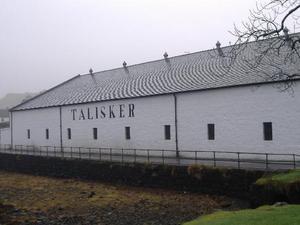
Together with Lagavulin, Talisker represented a heavier side of the single malt spectrum. Their barley (which is malted at Glen Ord) isn"t as peaty as Lagavulin"s (the Talisker "recipe" requires a peating level of +/- 22 PPM) but the whisky still makes a strong impression on most novices in the world of single malt Scotch. This was especially true in the 1990"s when Islay malts like Ardbeg and Caol Ila were not available as proper single malt "brands".
The remote island of Skye has many similarities with Islay - for one thing its Hebridean climate. Nevertheless, it"s usually classified as an "Island" whisky, which most experts consider to be part of the "Highlands" region. This means that Talisker is grouped together with a mish-mash of other malt whisky distilleries which have very different profiles, including Arran, Highland Park, Jura, Scapa and Tobermory. The distant location of Talisker was not chosen because that made the distillery hard to find for excise men that roamed the land in the illustrious illegal days of Scotch whisky. When the distillery was built in 1831 the whisky business had just turned legitimate - less than a decade earlier George Smith had just obtained the first proper license to distill whisky at Glenlivet distillery.
In 1988 Diageo launched the aforementioned "Classic Malts Selection" and a decade later they joined the finishing bandwagon with "double matured" expressions of their six classic malts. The "Distillers Edition" of Talisker was enhanced with a amoroso sherry finish. Over the years a number of limited editions was released and in 2004 Talisker expands the range with an 18yo expression (shown at the left) as well as a 25yo bottling.
In 2005 Talisker distillery celebrated its a birthday and released the "175th Anniversary" without an age statement. This was hardly a "limited edition"; some 60,000 bottles were produced. At the same time they launched another 25yo expression (the third edition).
2006 - The official Talisker range is expanded further with a 30yo OB - the oldest official bottling so far,
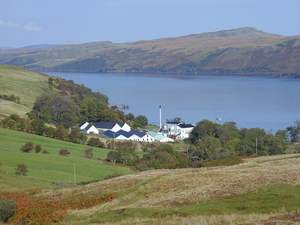
2008 - Yet another new bottling is added to the range; the Talisker NAS "57° North" (57%, OB, Bottled 2008).
A 30 years old bottling was first released in 2006, as well as another edition of its 25yo expression. These bottlings may not seem that old compared to releases in the ranges of Macallan or Dalmore, but for Talisker it was a significant departure. For the first ten years of the "Classic Malts Selection" only the 10yo standard bottling was available and after the "Distillers Edition" became available in 1998 they didn"t release any older expressions for a few years. So, older OB"s of Talisker are a fairly new phenomenon.
In the new Millenium
2004 - The range of official bottlings of Talisker is expanded with 18yo and 25yo expressions.
2005 - a "175th Anniversary" version without an age statement is released.
Trivia:
- Both Johnnie Walker whisky and Drambuie liqueur use Talisker as a component of their blended drinks; its presence is most notable in Walker"s Green Label 15 Year Old Vatted Malt.
- Talisker was the favourite whisky of writers Robert Louis Stevenson and Henry Vollam Morton. In his poem, The Scotsman"s Return From Abroad, Stevenson mentioned "The king o" drinks, as I conceive it, Talisker, Isla, or Glenlivet."
- Talisker was part of Diageo"s original series of six "Classic Malts", together with Cragganmore, Dalwhinnie, Glenkinchie, Lagavulin and Oban. This series was first released in 1988. Around 2005 a bunch of other distilleries were added to the range; Caol Ila, Cardhu, Clynelish, Glen Elgin, Glen Ord, Knockando and Royal Lochnagar.
from Malt Madness
The Owner: Diageo
| Established: 1997 |
| Silent since: False |
| Address: 8 Henrietta Place, London, W1G ONB, UK |
| → website |
Diageo also distributes Unicum, its lighter-bodied variant Zwack and Jose Cuervo tequila products in North America. However, Cuervo operates as a separate company in Mexico and is not owned by Diageo. Similarly Grand Marnier is distributed by Diageo in many markets, including exclusively in Canada, and a deal was reached in 2009 to significantly expand this partnership in Europe.
Furthermore, Diageo owns the Gleneagles Hotel.
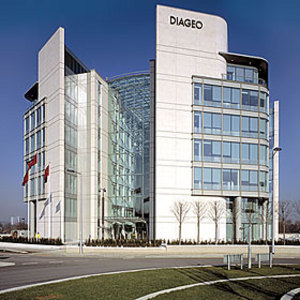
Diageo was formed in 1997 from the merger of Guinness plc and Grand Metropolitan plc. The creation was driven by the two executives Anthony Greener and Philip Yea at Guinness plus George Bull and John McGrath of Grand Metropolitan. The product portfolios of Guinness and Grand Met were largely complementary with little overlap.
Diageo is the world"s biggest whisky producer with 28 malt distilleries and two grain distilleries.The company operates the Scotch whisky distilleries of Auchroisk, Benrinnes, Blair Athol (situated at Pitlochry), Caol Ila, Cardhu, Knockando, Glen Elgin, Clynelish, Cragganmore, Dalwhinnie, Glenkinchie, Glen Ord, Lagavulin, Oban, Royal Lochnagar, Strathmill, Talisker, Teaninich, Mannochmore, Mortlach and Glenlossie, which are sold not only under their own name but used to make the various blended scotch whiskies sold by the company, and owns the stock of many closed distilleries such as Port Ellen, Rosebank, Brora, Convalmore, Glen Albyn, North Brechin, Banff, and Linlithgow. The company have opened a new malt distillery adjacent to their maltings at Roseisle (1st new make spirit produced Spring 2009). This will be one of the largest malt distilleries in Scotland. The new building contains 14 traditional copper pot stills. An expansion programme is also underway at its Cameron Bridge Grain Distillery in Fife that will make it the largest grain distillery in Scotland. Diageo also owns the Port Dundas Grain Distillery in Glasgow, and jointly operates the North British Grain Distillery in Gorgie, Edinburgh, with The Edrington Group.
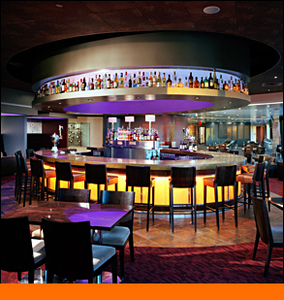
Diageo plc (LSE: DGE, NYSE: DEO) is the largest multinational beer, wine and spirits company in the world. The company is listed on the London Stock Exchange and has American Depositary Receipts listed on the New York Stock Exchange. The word Diageo was formed from the Latin dia (day) and the Greek geo (World), symbolising the use of the company"s brands every day, everywhere. Its head office is located in the City of Westminster in London. It is a constituent of the FTSE 100 Index.
Trivia:
- In December 2003, Diageo provoked controversy over its decision to change its Cardhu brand Scotch whisky from a single malt to a vatted malt (also known as a pure malt) whilst retaining the original name and bottle style. Diageo took this action because it did not have sufficient reserves to meet demand in the Spanish market, where Cardhu had been successful. After a meeting of producers, Diageo agreed to make changes.
- In 2006, the Cardhu brand quietly changed back to being a single malt.
- In July 2009, Diageo announced that, after nearly 200 years of association with the town of Kilmarnock, they would be closing the Johnnie Walker blending and bottling plant as part of restructuring to the business. This would make 700 workers unemployed and caused outrage from press, local people and politicians. A campaign against this decision was launched by the local SNP MSP Willie Coffey and Labour MP Des Browne. A petition was drawn up against the Diageo plans, which also involves the closure of the historic Port Dundas Grain Distillery in Glasgow.
- In February 2009 it was reported in the Guardian that the company had restructured itself so as to avoid paying tax in the U.K., despite much of its profits being generated in the U.K.
- Diageo is engaged in a tax scheme in the United States of America, commonly referred to as the "Rum Bailout", which will guarantee it USD$3 billion in revenues and profits.
- The National Puerto Rican Coalitionplans to run a series of ads in New York City and Puerto Rico urging a boycott of Diageo-owned alcoholic drinks to protest the giant British-owned corporation"s controversial production move of its Captain Morgan rum from Puerto Rico to the U.S. Virgin Islands.
from Wikipedia
